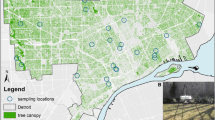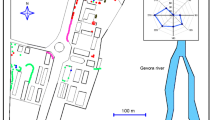Abstract
Nonparametric time-varying regression methods were developed to forecast daily ragweed pollen concentration, and the probability of the exceedance of a given concentration threshold 1 day ahead. Five-day and 10-day predictions of the start and end of the pollen season were also addressed with a nonparametric regression technique combining regression analysis with the method of temperature sum. Our methods were applied to three of the most polluted regions in Europe, namely Lyon (Rhône Valley, France), Legnano (Po River Plain, Italy) and Szeged (Great Plain, Hungary). For a 1-day prediction of both the daily pollen concentration and daily threshold exceedance, the order of these cities from the smallest to largest prediction errors was Legnano, Lyon, Szeged and Legnano, Szeged, Lyon, respectively. The most important predictor for each location was the pollen concentration of previous days. The second main predictor was precipitation for Lyon, and temperature for Legnano and Szeged. Wind speed should be considered for daily concentration at Legnano, and for daily pollen threshold exceedances at Lyon and Szeged. Prediction capabilities compared to the annual cycles for the start and end of the pollen season decreased from west to east. The order of the cities from the lowest to largest errors for the end of the pollen season was Lyon, Legnano, Szeged for both the 5- and 10-day predictions, while for the start of the pollen season the order was Legnano, Lyon, Szeged for 5-day predictions, and Legnano, Szeged, Lyon for 10-day predictions.







Similar content being viewed by others
References
Aznarte JL, Sánchez JMB, Lugilde DN, Fernández CDL, de la Guardia CD, Sánchez FA (2007) Forecasting airborne pollen concentration time series with neural and neuro-fuzzy models. Expert Syst Appl 32(4):1218–1225
Banken R, Comtois P (1992) Concentration of ragweed pollen and prevalence of allergic rhinitis in 2 municipalities in the Laurentides. Allerg Immunol 24:91–94
Bartkova-Scevkova J (2003) The influence of temperature, relative humidity and rainfall on the occurrence of pollen allergens (Betula, Poaceae, Ambrosia artemisiifolia) in the atmosphere of Bratislava (Slovakia). Int J Biometeorol 48(1):1–5
Béres I, Novák R, Hoffmanné Pathy Zs, Kazinczi G (2005) Spreading, morphology, biology, importance of mugwort leaves ragweed and possibilities of protection. [Az ürömlevelű parlagfű (Ambrosia artemisiifolia L.) elterjedése, morfológiája, biológiája, jelentősége és a védekezés lehetőségei.]. Gyomnövények, Gyomirtás 6(1):1–48, in Hungarian
Bottero P, Venegoni E, Riccio G, Vignati G, Brivio M, Novi C, Ortolani C (1990) Pollinosi da Ambrosia artemisiifolia in Provincia di Milano. Folia Allergol Immunol Clin 37(2):99–105
Cai Z (2007) Trending time-varying coefficient time series models with serially correlated errors. J Econometrics 136:163–188
Cassagne E (2009) Revue bibliographique des principaux seuils de détermination et méthodes de prévision de la date de début de pollinisation (DDP). Rev Fr Allergol 49(8):571–576
Castellano-Méndez M, Aira MJ, Iglesias I, Jato V, González-Manteiga W (2005) Artificial neural networks as a useful tool to predict the risk level of Betula pollen in the air. Int J Biometeorol 49(5):310–316
Chrenová J, Mičieta K, Ščevková J (2009) Monitoring of Ambrosia pollen concentration in the atmosphere of Bratislava (Slovakia) during years 2002–2007. Aerobiologia 26:83–88. doi:10.1007/s10453-009-9145-3
D’Amato G, Cecchi L (2008) Effects of climate change on environmental factors in respiratory allergic diseases. Clin Exp Allergy 38(8):1264–1274
D’Amato G, Cecchi L, Bonini S, Nunes C, Annesi-Maesano I, Behrendt H, Liccardi G, Popov T, van Cauwenberge P (2007) Allergenic pollen and pollen allergy in Europe. Allergy 62(9):976–990
Dechamp C, Rimet ML, Meon L, Deviller P (1997) Parameters of ragweed pollination in the Lyon's area (France) from 14 years of pollen counts. Aerobiologia 13:275–279
Fan J (1992) Design-adaptive nonparametric regression. J Am Stat Assoc 87:998–1004
Frei T, Gassner E (2008) Climate change and its impact on birch pollen quantities and the start of the pollen season an example from Switzerland for the period 1969–2006. Int J Biometeorol 52(7):667–674
Galán C, Cariňanos P, García-Mozo H, Alcázar P, Domínguez-Vilches E (2001) Model for forecasting Olea europaea L. airborne pollen in South-West Andalusia, Spain. Int J Biometeorol 45(2):59–63
García-Mozo H, Galán C, Belmonte J, Bermejo D, Candau P, de la Guardia CD, Elvira B, Gutierrez M, Jato V, Silva I, Trigo MM, Valencia R, Chuine I (2009) Predicting the start and peak dates of the Poaceae pollen season in Spain using process-based models. Agric For Meteorol 149(2):256–262
Hirst JM (1952) An automatic volumetric spore trap. Ann Appl Biol 39:257–265
Ianovici N, Sîrbu C (2007) Analysis of airborne ragweed (Ambrosia artemisiifolia L.) pollen in Timişoara, 2004. An Univ Oradea Fascicula Biol 14:101–108
Jäger S (1998) Global aspect of ragweed in Europe. In: Spieksma FThM (ed) Satellite Symposium Proceedings: Ragweed in Europe. Proceedings of the 6th International Congress on Aerobiology. Alk-Abelló, Perugia (Italy), pp 6–10
Juhász M (1998) History of ragweed in Europe. In: Spieksma FThM (ed) Ragweed in Europe. Satellite Symposium Proceedings of the 6th International Congress on Aerobiology. Alk-Abelló, Perugia (Italy), pp 11–14
Kasprzyk I (2008) Non-native Ambrosia pollen in the atmosphere of Rzeszow (SE Poland); evaluation of the effect of weather conditions on daily concentrations and starting dates of the pollen season. Int J Biometeorol 52(5):341–351
Köppen W (1931) Grundriss Der Klimakunde. De Gruyter, Berlin
Laaidi M (1997) Influence des facteurs météorologiques sur la concentration du pollen dans l’air. Climat Santé 17:7–25
Laaidi M (2001) Regional variations in the pollen season of Betula in Burgundy: two models for predicting the start of the pollination. Aerobiologia 17(3):247–254
Laaidi M, Thibaudon M, Besancenot JP (2003) Two statistical approaches to forecasting the start and duration of the pollen season of Ambrosia in the area of Lyon (France). Int J Biometeorol 48:65–73
Lejoly-Gabriel HL (1978) Recherches écologiques sur la pluie pollinique en Belgique. Acta Geogr Lovan 13:1–278
Li Q, Racine J (2004) Cross-validated local linear nonparametric regression. Stat Sinica 14:485–512
Makra L, Juhász M, Borsos E, Béczi R (2004) Meteorological variables connected with airborne ragweed pollen in Southern Hungary. Int J Biometeorol 49(1):37–47
Makra L, Juhász M, Béczi R, Borsos E (2005) The history and impacts of airborne Ambrosia (Asteraceae) pollen in Hungary. Grana 44(1):57–64
Makra L, Sz T, Bálint B, Sümeghy Z, Sánta T, Hirsch T (2008) Influences of meteorological parameters and biological and chemical air pollutants to the incidence of asthma and rhinitis. Climate Res 37(1):99–119
Mandrioli P, Di Cecco M, Andina G (1998) Ragweed pollen: The aeroallergen is spreading in Italy. Aerobiologia 14:13–20
Nilsson S, Persson S (1981) Tree pollen spectra in the Stockholm region (Sweden), 1973-1980. Grana 20:179–182
Ocana-Peinado F, Valderrama MJ, Aguilera AM (2008) A dynamic regression model for air pollen concentration. Stoch Environ Res Risk A 22:S59–S63
Peternel R, Čulig J, Hrga I, Hercog P (2006) Airborne ragweed (Ambrosia artemisiifolia L.) pollen concentrations in Croatia, 2002–2004. Aerobiologia 22(3):161–168
Puc M (2006) Ragweed and mugwort pollen in Szczecin, Poland. Aerobiologia 22(1):67–78
Ribeiro H, Cunha M, Abreu I (2008) Quantitative forecasting of olive yield in Northern Portugal using a bioclimatic model. Aerobiologia 24(3):141–150
Rodríguez-Rajo FJ, Jato V, Aira MJ (2005) Relationship between meteorology and Castanea airborne pollen. Belg J Bot 138(2):129–140
Rodríguez-Rajo FJ, Valencia-Barrera RM, Vega-Maray AM, Suarez FJ, Fernandez-Gonzalez D, Jato V (2006) Prediction of airborne Alnus pollen concentration by using Arima models. Ann Agric Environ Med 13(1):25–32
Rodríguez-Rajo FJ, Grewling L, Stach A, Smith M (2009) Factors involved in the phenological mechanism of Alnus flowering in Central Europe. Ann Agric Environ Med 16(2):277–284
Rodríguez-Rajo FJ, Astray G, Ferreiro-Lage JA, Aira MJ, Jato-Rodriguez MV, Mejuto JC (2010) Evaluation of atmospheric Poaceae pollen concentration using a neural network applied to a coastal Atlantic climate region. Neural Netw 23(3):419–425
Ruml M, Vukovič A, Milatovič D (2009) Evaluation of different methods for determining growing degree-day threshold in apricot cultivars. Int J Biometeorol 54:411–422. doi:10.1007/s00484-009-0292-06
Sánchez Mesa JA, Galán C, Hervás C (2005) The use of discriminant analysis and neural networks to forecast the severity of the Poaceae pollen season in a region with a typical Mediterranean climate. Int J Biometeorol 49(6):355–362
Šikoparija B, Smith M, Skjøth CA, Radišič P, Milkovska S, Šimič S, Brandt J (2009) The Pannonian plain as a source of Ambrosia pollen in the Balkans. Int J Biometeorol 53(3):263–272
Snyder RI, Spano D, Cesaraccio C, Duce P (1999) Determining degree-day thresholds from field observations. Int J Biometeorol 42:177–182
Stach A, Smith M, Baena JCP, Emberlin J (2008) Long-term and short-term forecast models for Poaceae (grass) pollen in Poznań, Poland, constructed using regression analysis. Environ Exp Bot 62(3):323–332
Štefanič E, Kovačevič V, Lazanin Ž (2005) Airborne ragweed pollen concentration in north-eastern Croatia and its relationship with meteorological parameters. Ann Agric Environ Med 12:75–79
Stepalska D, Myszkowska D, Wolek J, Piotrowicz K, Obtulowicz K (2008) The influence of meteorological factors on Ambrosia pollen loads in Cracow, Poland, 1995–2006. Grana 47(4):297–304
Teran L, Haselbarth-Lopez MMM, Quiroz-Garcia DL (2009) Allergy, pollen and the environment. Gac Méd Méx 145(3):215–222
Traidl-Hoffmann C, Kasche A, Menzel A, Jakob T, Thiel M, Ring J, Behrendt H (2003) Impact of pollen on human health: More than allergen carriers? Int Arch Allergy Imm 131:1–13
Turos OI, Kovtunenko IN, Markevych YP, Drannik GN, DuBuske LM (2009) Aeroallergen monitoring in Ukraine reveals the presence of a significant ragweed pollen season. J Allergy Clin Immun 123(2):S95-S95, Suppl. S358
Verma KS, Pathak AK (2009) A comparative analysis of forecasting methods for aerobiological studies. Asian J Exp Sci 23:193–198
Wan SQ, Yuan T, Bowdish S, Wallace L, Russell SD, Luo YQ (2002) Response of an allergenic species Ambrosia psilostachya (Asteraceae), to experimental warming and clipping: Implications for public health. Am J Bot 89(11):1843–1846
Wopfner N, Gadermaier G, Egger M, Asero R, Ebner C, Jahn-Schmid B, Ferreira F (2005) The spectrum of allergens in ragweed and mugwort pollen. Int Arch Allergy Imm 138:337–346
Acknowledgements
The authors would like to thank Gilles Oliver for his part in collecting the pollen data for Lyon, Miklós Juhász for providing pollen data of Szeged, and Zoltán Sümeghy for the digital mapping in Fig. 1.
Author information
Authors and Affiliations
Corresponding author
Rights and permissions
About this article
Cite this article
Makra, L., Matyasovszky, I., Thibaudon, M. et al. Forecasting ragweed pollen characteristics with nonparametric regression methods over the most polluted areas in Europe. Int J Biometeorol 55, 361–371 (2011). https://doi.org/10.1007/s00484-010-0346-9
Received:
Revised:
Accepted:
Published:
Issue Date:
DOI: https://doi.org/10.1007/s00484-010-0346-9




